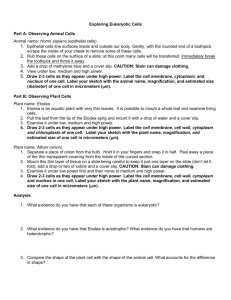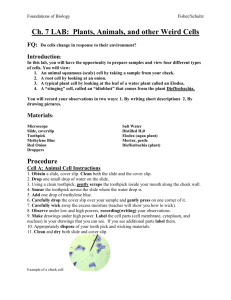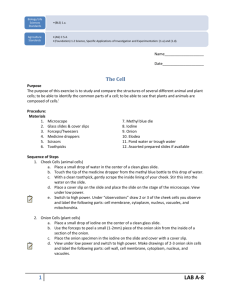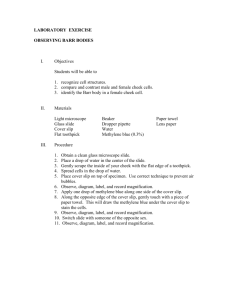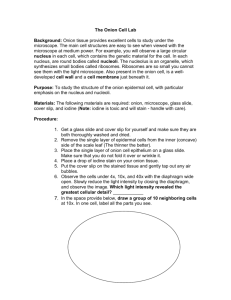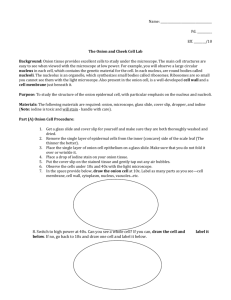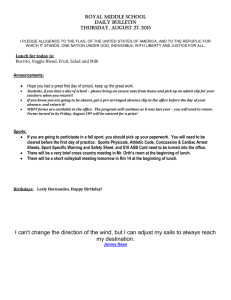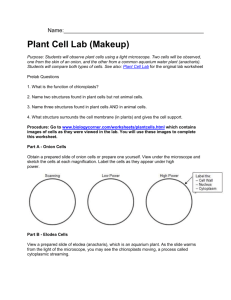Plants, Animals, and other Weird Cells
advertisement
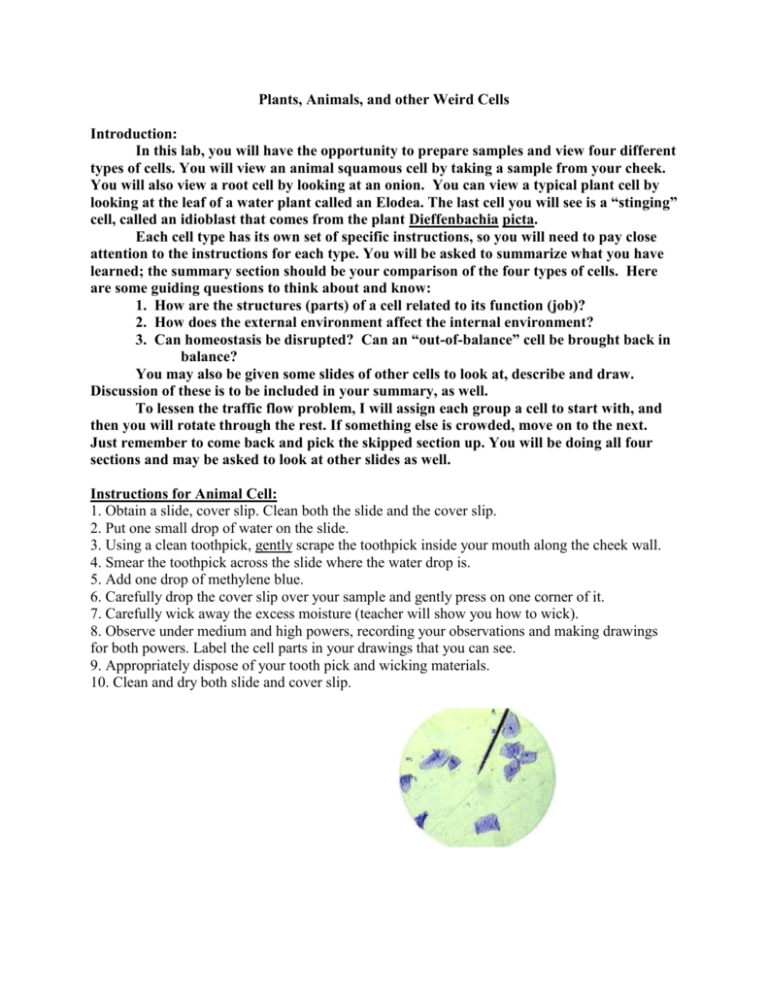
Plants, Animals, and other Weird Cells Introduction: In this lab, you will have the opportunity to prepare samples and view four different types of cells. You will view an animal squamous cell by taking a sample from your cheek. You will also view a root cell by looking at an onion. You can view a typical plant cell by looking at the leaf of a water plant called an Elodea. The last cell you will see is a “stinging” cell, called an idioblast that comes from the plant Dieffenbachia picta. Each cell type has its own set of specific instructions, so you will need to pay close attention to the instructions for each type. You will be asked to summarize what you have learned; the summary section should be your comparison of the four types of cells. Here are some guiding questions to think about and know: 1. How are the structures (parts) of a cell related to its function (job)? 2. How does the external environment affect the internal environment? 3. Can homeostasis be disrupted? Can an “out-of-balance” cell be brought back in balance? You may also be given some slides of other cells to look at, describe and draw. Discussion of these is to be included in your summary, as well. To lessen the traffic flow problem, I will assign each group a cell to start with, and then you will rotate through the rest. If something else is crowded, move on to the next. Just remember to come back and pick the skipped section up. You will be doing all four sections and may be asked to look at other slides as well. Instructions for Animal Cell: 1. Obtain a slide, cover slip. Clean both the slide and the cover slip. 2. Put one small drop of water on the slide. 3. Using a clean toothpick, gently scrape the toothpick inside your mouth along the cheek wall. 4. Smear the toothpick across the slide where the water drop is. 5. Add one drop of methylene blue. 6. Carefully drop the cover slip over your sample and gently press on one corner of it. 7. Carefully wick away the excess moisture (teacher will show you how to wick). 8. Observe under medium and high powers, recording your observations and making drawings for both powers. Label the cell parts in your drawings that you can see. 9. Appropriately dispose of your tooth pick and wicking materials. 10. Clean and dry both slide and cover slip. Instructions for Onion Cell: 1. Clean and dry your slide and cover slip. 2. Obtain a very thin section of onion from your teacher 3. Place one drop of water on the onion. 4. Place one drop of iodine stain on the water. **Be careful, iodine is a poison and will stain. 5. Wait 20 seconds and then wick off as much as the moisture as possible without completely drying or touching the onion. 6. Place the cover slip over the sample and press lightly on one corner to remove the air bubbles. 7. Observe the onion on both medium and high powers, making quality observations and drawings. Label all of the cell parts in each drawing that you can see. 8. While you are watching on medium or high power, add several drops of salt water to the side of your cover slip and wick it through by using a piece of paper towel on the opposite side of the cover slip. 9. Wait several minutes, record your observations and draw what you now see. Label that part(s) that you could not see before. 10. Add several drops of distilled H2O to the slide. Wait several minutes. Record you observations. 11. Appropriately discard the sample, clean and dry both cover slip and slide thoroughly. Instructions for Elodea: 1. Clean and dry the slide and cover slip. 2. Get a small leaf of the Elodea. 3. Put a drop of water on your slide and set the leaf on it. 4. Use a cover slip to help flatten the leaf; push gently on the corner of the slip to try to remove any air bubbles. 5. View under medium and high power. After several minutes under the light, make quality observations and drawings. Label the parts of the cell in your drawings that you can see. 6. Appropriately discard your leaf sample, clean and dry your slide and cover slip thoroughly. Instructions for Idioblasts: Readings: Idioblasts that Shoot (Original source: The Remarkable Shooting Idioblast, Carolina Tips). The ejection of sharp, needle-like crystals from specialized spindle-shaped cells of the plant Dieffenbachia picta is a phenomenon that is neat to watch. People are fascinated when they see these distinctive cells, called idioblasts; shoot out needle after needle--like a microscopic blow gun. Each idioblast (see Fig. A) contains a large bundle of double pointed, sharp, needlelike crystals called raphids. Forceful ejection of the raphids can sometimes be seen under a microscope. A B The raphids are made of calcium oxalate, which is actually a non-living piece of material that exists inside this cell. It has been speculated that these raphids help the plant to use excess oxalate. The raphids are formed in a special vacuole within the cells. It is also speculated that the raphids may be an evolutionary adaptation to help the plant survive. Any animal that tries to eat the stem or leaves of the Dieffenbachia will not enjoy the experience. Dieffenbachia is also known as Dumb Cane, because it has been widely known for centuries that when a human tries to eat the plant, the mouth and throat will become paralyzed, thus causing the person not to be able to speak (being dumb) and even not being able to eat for a full day or more. For many years it was thought that the calcium oxalate was the paralyzing agent in the plant, but in 1972, it was found that the plant tissue actually contains a venomous enzyme similar to snakes and scorpions. The raphids allow the venom to enter the mouth and throat tissue, and the venom travels down small grooves on the opposite side of the raphids and enter the cells of the throat. Scanning electron micrographs suggest that the raphids are also barbed, which would prevent them from dislodging. When crushed plant tissue is placed in a drop of water on a glass slide and put under a microscope, some idioblasts will be seen firing and others will be still (see Fig. B). It was not known why this was so, until it was observed under a scanning microscope with a color video monitor. The camera showed that cells that were not firing had smooth round tips, while the firing tips were broken and jagged. The number of raphids fired is proportional to the amount of damage done to the tip. It seems to be the water pressure, called turgor pressure inside of the idioblast that forces out the raphids. When the pressure is high, they fire. How this works is that the raphids are surrounded by a jelly-like substance that puts pressure on them. As the turgor, or water pressure increases in the idioblast due to something literally “putting the squeeze” on the outside (i.e. a “bite”), the raphids are literally squirted out the end. The more the pressure, the more they “squirt,” or fire. Once the last of the raphids is ejected, the idioblast literally spills its guts if the pressure remains. Instructions for the Lab: 1. Obtain a mortar and pestle and a small chunk (less than 1 square inch) of the plant. 2. Put 15 drops of water in the mortar and add the piece of plant. 3. Crush and mix the plant for 2-3 minutes. 4. Let the pestle rest on the mortar (at a slight angle) for 2 minutes. 5. With a dropper, put 1-2 drops of mixture from the bottom of the mortar on a slide with a cover slip. 6. Examine under low power until you find an idioblast, and work up to medium & high power. 7. If most of our idioblasts are unbroken, mash the stuff in the mortar some more and prepare a new slide. 8. Record quality observations and draw what you see out of each slide set, labeling the parts. 9. Carefully clean, wash, rinse, and dry the mortar, pestle, slide, and cover slip. 10. Find out if your teacher has any other slides for you to look at. Follow the directions given for those slides. 11. When you are finished with all four cells, put the microscope to “bed” in the proper manner. Questions for the Lab: 1. Describe the differences between the Elodea and the onion. 2. Hypothesize/explain why there are these differences (as described in #1), even though they are both plant cells. 3. Describe the differences between typical plant and animal cells. 4. Describe the general shape of your cheek cells. Write an explanation why they wouldn’t be round like most “models” show animal cells. 5. Describe the differences between the idioblast cells and normal plant cells. What is it about idioblasts that make them so special? 6. Summarize the firing mechanism of the raphids (See the reading section above). 7. Estimate the size of each: length of a human cheek and onion cells, width of a raphid in micrometers (um). See pages 428-429 for help and reminders. 8. When observing the Elodea, you should have noticed that the Chloroplasts were moving around the inside of the cell. This is called cytoplasmic streaming. Hypothesize why it took several minutes for you to notice that happening. Hint: It is tied to the job of the chloroplast. 9. Hypothesize why there is a difference in the cell structures between plants and animals and explain why those differences are important for the way the different organisms live. 10. If homeostasis is disrupted, can it be corrected? Use evidence from the lab to support your answer.
